The Bald Beast of Kitchenuhmaykoosib Inninuwug
Posted by: Loren Coleman on May 20th, 2010
What is it?
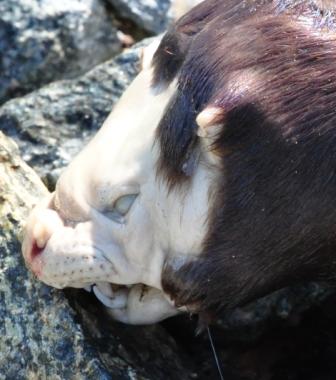
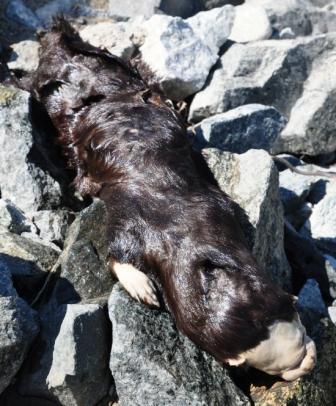
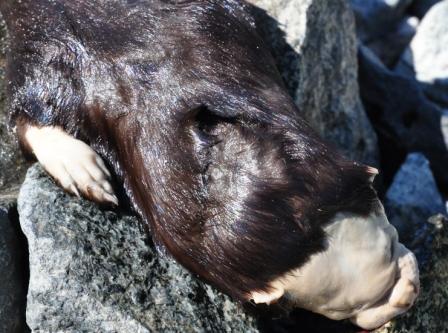
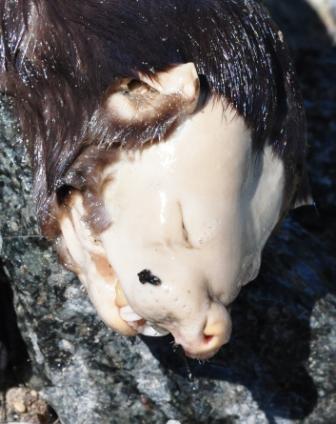
The new photos of the recently discovered dead animal found in a northern Ontario waterway has the potential to be another “Montauk Monster” situation. Local media in Canada is already going bananas with the beast story.
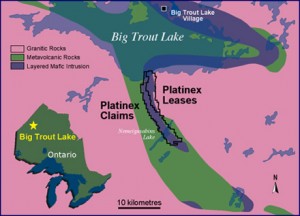
Where is all of this happening? The strange dead body was pulled from a local creek in early May 2010 at Kitchenuhmaykoosib Inninuwug (Oji-Cree: ᑭᐦᒋᓇᒣᑯᐦᓯᑊ ᐃᓂᓂᐧᐊᐠ (Gichi-namegosib ininiwag); unpointed: ᑭᒋᓇᒣᑯᓯᑊ ᐃᓂᓂᐧᐊᐠ or ᑭᐦᒋᓇᒣᑯᐦᓯᐱᐎᓂᓂᐗᐠ (Gichi-namegosibiwininiwag); unpointed: ᑭᒋᓇᒣᑯᓯᐱᐎᓂᓂᐗᐠ). The location is also known as Big Trout Lake First Nation or KI for short, and it is a First Nations community in northwestern Ontario. The community is about 580 km (360 mi) north of Thunder Bay, Ontario.
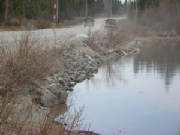
The backstory of the Bald Beast of KI is that a local dog named Sam, with its two owners, women nurses, found the beast floating face down in the creek, and they pulled it from the water. They then took photographs of the less-than-foot long, 30-centimetre-long dead creature.
Images (as above) of the furry, bald-faced creature were then placed on the official website of the Big Trout Lake community and have since caused an uproar of speculation on the Internet.
Of course, media outlets have already mentioned the Canadian Ogopogo, Scotland’s Loch Ness Monster, and the Latino Chupacabras.
But more realistic considerations have talked about it being a known species, such as a bear cub (Ursus americanus) or other animals. Even the mundane looks strange without hair.
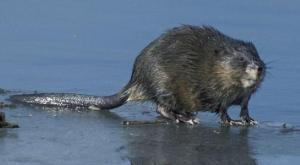
However, with the structure of the head, the description of a “rat-like” tail, and the 11-inch-length, one suggestion is that it might be a semi-aquatic rodent, the muskrat (Ondatra zibethicus). Two views of muskrat skulls are below.
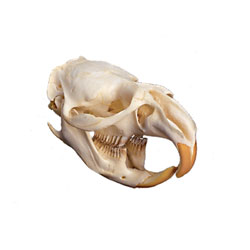
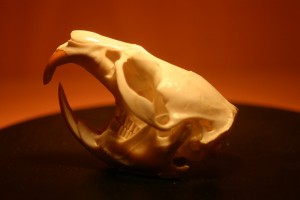
The other top candidate is that of the North American river otter (Lontra canadensis). Yes, it could simply be a dead river otter.
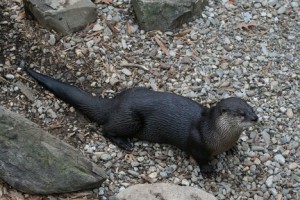
Two views of river otter skulls are below.
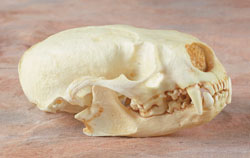
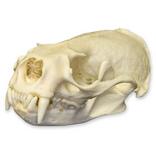
Thanks for the heads up from Peter Leronowich.
UPDATE.
Media attention: The Toronto Star ran a story on Friday, May 21, 2010, in which they mentioned this posting in Cryptomundo. They also picked one comment out to highlight. The conclusion of their article reads:
Cryptomundo.com, a site devoted to “elusive and rare animals,” has done an analysis of various small animals’ skulls, with the muskrat seeming a close match—although the nasty teeth were judged un-muskrat-like.
Others speculate it may be the mythical Ogopogo, the Chupacabra or some other marine monster, like the Loch Ness Monster.
“But more realistic considerations have talked about it being a known species, such as a bear cub (Ursus americanus) or other animals. Even the mundane looks strange without hair,” Loren Coleman at Cryptomundo said.
“The other top candidate is that of the North American river otter (Lontra canadensis).”
A New Zealand zoologist examined the teeth, whiskers and paws and decided:
“I think this is just another variation of an ordinary creature sculpted by the action of decomposition by water, as I demonstrated last year with the Gisbourne New Zealand Monster that was actually a drowned Opossum.”
CTV carried extensive coverage of this story on Friday, as well, and it spread throughout the mainstream press as the day progressed.
About Loren Coleman
Loren Coleman is one of the world’s leading cryptozoologists, some say “the” leading living cryptozoologist. Certainly, he is acknowledged as the current living American researcher and writer who has most popularized cryptozoology in the late 20th and early 21st centuries.
Starting his fieldwork and investigations in 1960, after traveling and trekking extensively in pursuit of cryptozoological mysteries, Coleman began writing to share his experiences in 1969. An honorary member of Ivan T. Sanderson’s Society for the Investigation of the Unexplained in the 1970s, Coleman has been bestowed with similar honorary memberships of the North Idaho College Cryptozoology Club in 1983, and in subsequent years, that of the British Columbia Scientific Cryptozoology Club, CryptoSafari International, and other international organizations. He was also a Life Member and Benefactor of the International Society of Cryptozoology (now-defunct).
Loren Coleman’s daily blog, as a member of the Cryptomundo Team, served as an ongoing avenue of communication for the ever-growing body of cryptozoo news from 2005 through 2013. He returned as an infrequent contributor beginning Halloween week of 2015.
Coleman is the founder in 2003, and current director of the International Cryptozoology Museum in Portland, Maine.










Well we all know the hair loss is due to the time the body has been in the water, as is the pale skin. This animal has obviously not been in the water long enough for all the hair to fall off, but you can see the process developing in the area of the paws.
Obviously a carnivore by the dentation and has whiskers which have obviously fallen out as the pits are still visable.
What ever it is relys heavily on smell by the look of the nose and the short ears. The muzzel almost looks like it has been scrunched.
I think this is just another variation of an ordinary creature sculpted by the action of decomposition by water, as I demonstrated last year with the Gisbourne New Zealand Monster that was actually a drowned Opossum.
I want to say that the beast looks like a decomposing otter, possibly a river otter (Lontra canadensis). It’s sleek body suggest that it’s from the weasel family or the mustelids. I guess we’ll never know since the body is “gone” but generally it’s much easier to examine the skull or bones itself.
The view of the teeth isn’t great, but I think the relative size and spacing rules out a muskrat or other rodent (the most prominent appear to be canines rather than incisors). The “rat-like” appearance of the tail could be referring to hairlessness which may or may not be its natural state.
It’s an otter, or something very similar.
The coat of this creature is similar to that of a sloth, but the skull, specifically the front teeth, are more similar to that of an otter. Given the location, it could be a river otter with a disease.
Yeah, I would say a river otter. The fur is the right color and the facial features scream otter of some sort. Just a little bloated, loss of fur…etc.
It is most likely that it is an otter. The shape of the body would indicate this, as well as the colour and structure of the remaining fur. The head is also like those of an otter. Many mustelids have only a proportionally short “face”, and the skull is behind the eyes very elongated, whilst the muzzle is short. There is not much too see from the teeth, but they istantly rule out any rodents and perfectly fit those of an otter. If you look at the polyurethane foam bodies used by taxidermists you can also see how a fur-less otter looks, and the head morphology of a hairless otter is also like those of the “mysterious” carcass.
What I find really strang is that again no photos of the whole body in straight line are shown. This would make everything so much easier (okay, this case is easy anyway), if people would make photos which show not only the whole carcass, but also from different angles, with details photos of the head and paws, and especially with a good size comparison. When I see a rare or unusual animal I do this too, and whenever possible I also make photos with size comparisons, for example with my mobile phone or a similar item which illustrates the actual sizes.
Otter
I say Otter, the teeth seem to match the most of any of the pictures and just for clarity, otters DON”T taste like chicken, at all.
Further info I’ve uncovered up here in Canada from our paper The Globe and Mail.
Some residents of Big Trout Lake, an Oji-Cree community of 1,200 south of Hudson Bay, believe the animal is a rare local creature known as an omajinaakoos, which roughly translates to “ugly one”. Band councillor Darryl Sainnawap said his great uncle spotted one about 50 years ago.
“He says in his younger days he was with his grandfather … and he did see this same creature and that’s the last time he saw it,” he said. “His grandfather called him omajinaakoos.”
Some local elders in the community, which is also known as Kitchenuhmaykoosib Inninuwug, believe the animal is a messenger of bad news.
“No one knows what it is but our ancestors used to call it the Ugly One. Rarely seen but when seen, it’s a bad omen. Something bad will happen according to our ancestors,” the community’s website says.
Mr. Sainnawap, 25, said the animal lives in swamps and feeds on beavers. Asked how the small critter could eat a beaver, he said: “That’s a good question. How could a wolverine take down a moose?”
http://www.theglobeandmail.com/news/national/ontario/big-trout-lake-monster-sparks-internet-debate/article1576748/
Now the puzzling thing is why some one on the reserve can’t identify it as an otter or local species when they make a living off the bush. Surely you would think with all the beaver, marten, otter, muskrat etc they’d know, probably even come across the dead before. The thing is the traditional life style isn’t practised as much on the reserves as one may think. I’ve met several people from reserves in our nation that couldn’t tell a dobie from a sheppard. But there have been some I’ve talked to that have told me wonderous tales of the woods, some passed down from generation to generation. My favorite was the Wendigo although I recall it having another name.
I guess since this is the only evidence the book can’t be closed but I still lean toward otter. This isn’t a scientific conclussion mind you just something from distant memory I remember from my youth…wish my organic hard drive would cough it up but like the otter it’s gone….why does everything taste like chicken??? Peter l
We can deffinatly rule out the possibility of it being a muskrat. If you would look at the paws, and then the paws of a muskrat, they don’t resemble each other at all.
Most likely, it belongs to the weasel(mustelid) family because of it’s long body, thick fur, small ears, tail, head shape, and basicly everything else. To be more specific, I want to say it’s a mink or otter. I would say the mink would make more sense size-wize because it only grows to be 20-25 inches long. The mink also is best known for it’s think, luxerious pelt, as you can see in the picture, it would make sense that my theory is pretty likely.
Hey, nice marmot!
OK OK shameless Big Lebowski quote ;p
I couldn’t resist!!
~Peace
Definitely a mustelid. I agree with nikki, it looks more like a mink than an otter. It may also be a fisher (one step up in size from a marten and two steps up from a mink).